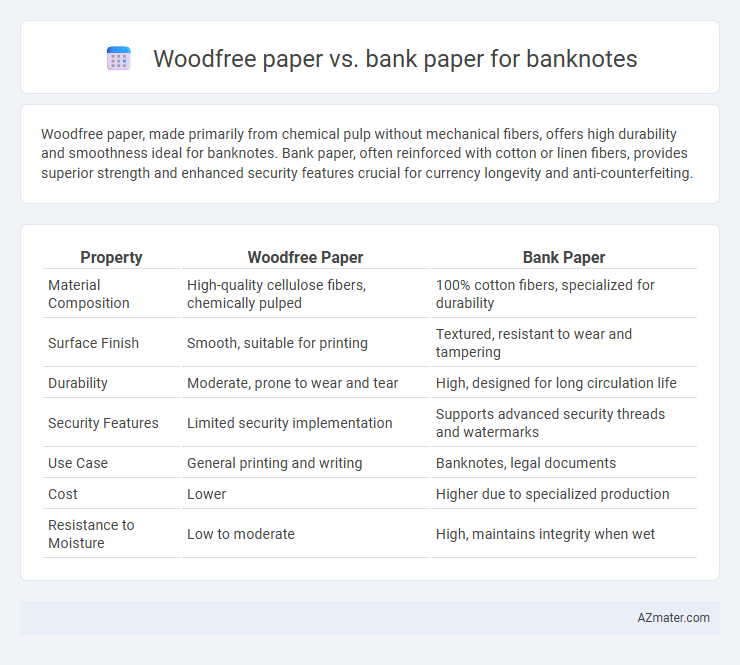Woodfree paper, made primarily from chemical pulp without mechanical fibers, offers high durability and smoothness ideal for banknotes. Bank paper, often reinforced with cotton or linen fibers, provides superior strength and enhanced security features crucial for currency longevity and anti-counterfeiting.
Table of Comparison
| Property | Woodfree Paper | Bank Paper |
|---|---|---|
| Material Composition | High-quality cellulose fibers, chemically pulped | 100% cotton fibers, specialized for durability |
| Surface Finish | Smooth, suitable for printing | Textured, resistant to wear and tampering |
| Durability | Moderate, prone to wear and tear | High, designed for long circulation life |
| Security Features | Limited security implementation | Supports advanced security threads and watermarks |
| Use Case | General printing and writing | Banknotes, legal documents |
| Cost | Lower | Higher due to specialized production |
| Resistance to Moisture | Low to moderate | High, maintains integrity when wet |
Introduction to Banknote Paper Types
Banknote paper primarily consists of specialized fibers designed for durability and security, with woodfree paper and bank paper serving distinct roles. Woodfree paper, made from chemical pulp without mechanical wood fibers, offers a smooth surface ideal for high-quality printing but lacks the enhanced strength and security features of traditional bank paper. Bank paper, typically composed of cotton or linen fibers, provides superior tactile feel, longevity, and resistance to counterfeiting, making it the preferred choice for currency production.
What is Woodfree Paper?
Woodfree paper is a high-quality paper made from chemical pulp with minimal lignin content, resulting in a smooth, bright, and durable surface ideal for printing. Unlike bank paper, which often contains cotton fibers for enhanced strength and durability, woodfree paper primarily uses wood-derived pulp, making it less resistant to wear and tampering. Woodfree paper's fine texture and opacity make it suitable for high-resolution printing but less preferred for secure banknotes requiring anti-counterfeiting properties.
What is Bank Paper?
Bank paper is a high-quality, durable paper specifically designed for printing banknotes, featuring enhanced durability, security fibers, and watermarks to prevent counterfeiting. Unlike woodfree paper, which is primarily made from chemical pulp for smoothness and whiteness, bank paper incorporates cotton fibers or other materials to withstand wear and provide added security features. This specialized composition ensures longevity and resistance to tampering, making bank paper the preferred choice for secure currency production.
Key Material Differences
Woodfree paper, primarily composed of bleached chemical pulp without mechanical wood fibers, offers higher purity and durability essential for banknotes. Bank paper, specifically designed for currency, often integrates cotton fibers or other durable materials to enhance strength, water resistance, and longevity. The key material difference lies in woodfree paper's pulp composition, while bank paper combines cotton and specialized fibers to meet stringent security and durability standards.
Durability and Lifespan Comparison
Woodfree paper, typically made from chemical pulp without mechanical fibers, offers moderate durability but is more prone to wear and tear compared to bank paper specifically engineered for currency. Bank paper incorporates cotton or linen fibers, significantly enhancing its tensile strength, resistance to folding, and longevity, making it ideal for banknotes subjected to frequent handling. The lifespan of bank paper can exceed several years in circulation, whereas woodfree paper tends to degrade much faster under similar conditions, limiting its suitability for durable banknotes.
Security Features Integration
Woodfree paper offers a smooth surface ideal for high-resolution printing, enhancing the integration of complex security features such as microtext and intaglio printing for banknotes. Bank paper, traditionally made from cotton fibers, provides superior durability and a more tactile texture that supports embedding advanced security elements like watermarks, security threads, and polymer windows. The choice between woodfree and bank paper significantly impacts the effectiveness and longevity of security features essential for counterfeit resistance in banknotes.
Printing Quality and Performance
Woodfree paper offers superior printing quality for banknotes due to its smooth surface and high brightness, ensuring sharp and clear image reproduction. Bank paper, specifically designed for currency, excels in durability and resistance to wear, enhancing the overall performance and longevity of banknotes under frequent handling. The combination of woodfree paper's fine finish and the specialized composition of bank paper optimizes anti-counterfeiting features and tactile security elements critical for reliable banknote production.
Environmental Considerations
Woodfree paper, often produced from chemical pulps and free of mechanical wood particles, offers higher durability and reduced lignin content, resulting in better resistance to yellowing and degradation over time, which is crucial for long-lasting banknotes. Bank paper, typically made from cotton or a cotton blend, is highly durable and biodegradable, making it environmentally preferable due to its renewable raw material base and lower impact on deforestation. Choosing bank paper for banknotes supports sustainability efforts by promoting the use of natural fibers with superior recyclability and minimal environmental footprint compared to woodfree papers derived from traditional wood pulp sources.
Cost and Production Factors
Woodfree paper, made from chemical pulp with minimal lignin, offers higher durability and a smoother surface ideal for banknotes but incurs greater production costs due to the intensive processing required. Bank paper, typically a cotton-based or blended material, is cost-effective with enhanced strength and flexibility, making it suitable for widespread currency printing while allowing faster production cycles. The choice between woodfree and bank paper balances cost-efficiency against the necessity for durability and anti-counterfeit features in banknote manufacturing.
Choosing the Right Paper for Banknotes
Selecting the right paper for banknotes involves evaluating durability, security features, and cost-effectiveness, with woodfree paper offering a smooth, high-quality surface ideal for detailed printing and bank paper designed to withstand frequent handling and tampering. Woodfree paper, made from chemical pulp with minimal lignin, ensures longevity and resistance to yellowing, enhancing the lifespan and aesthetic clarity of banknotes. Bank paper incorporates embedded security elements like watermarks and security threads, making it preferable for anti-counterfeiting measures despite higher production costs compared to standard woodfree paper.

Infographic: Woodfree paper vs Bank paper for Banknote
 azmater.com
azmater.com